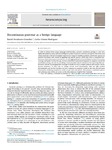Mostrar o rexistro simple do ítem
Discontinuous grammar as a foreign language
| dc.contributor.author | Fernández-González, Daniel | |
| dc.contributor.author | Gómez-Rodríguez, Carlos | |
| dc.date.accessioned | 2023-03-22T11:31:18Z | |
| dc.date.available | 2023-03-22T11:31:18Z | |
| dc.date.issued | 2023-03 | |
| dc.identifier.citation | Fernández_González, Daniel; Gómez-Rodríguez, Carlos (2023): Discontinuous grammar as a foreign language. Neurocomputing 524: 43–58 | es_ES |
| dc.identifier.issn | 0925-2312 | |
| dc.identifier.uri | http://hdl.handle.net/2183/32741 | |
| dc.description.abstract | [Abstract] In order to achieve deep natural language understanding, syntactic constituent parsing is a vital step, highly demanded by many artificial intelligence systems to process both text and speech. One of the most recent proposals is the use of standard sequence-to-sequence models to perform constituent parsing as a machine translation task, instead of applying task-specific parsers. While they show a competitive performance, these text-to-parse transducers are still lagging behind classic techniques in terms of accuracy, coverage and speed. To close the gap, we here extend the framework of sequence-to-sequence models for constituent parsing, not only by providing a more powerful neural architecture for improving their performance, but also by enlarging their coverage to handle the most complex syntactic phenomena: discontinuous structures. To that end, we design several novel linearizations that can fully produce discontinuities and, for the first time, we test a sequence-to-sequence model on the main discontinuous benchmarks, obtaining competitive results on par with task-specific discontinuous constituent parsers and achieving state-of-the-art scores on the (discontinuous) English Penn Treebank. | es_ES |
| dc.description.sponsorship | Xunta de Galicia; ED431G 2019/01 | es_ES |
| dc.description.sponsorship | Xunta de Galicia; ED431C 2020/11 | es_ES |
| dc.description.sponsorship | We acknowledge the European Research Council (ERC), which has funded this research under the European Union’s Horizon 2020 research and innovation programme (FASTPARSE, grant agreement No 714150) and the Horizon Europe research and innovation programme (SALSA, grant agreement No 101100615), ERDF/ MICINN-AEI (SCANNER-UDC, PID2020-113230RB-C21), Xunta de Galicia (ED431C 2020/11), and Centro de Investigación de Galicia ‘‘CITIC”, funded by Xunta de Galicia and the European Union (ERDF - Galicia 2014–2020 Program), by grant ED431G 2019/01. Funding for open access charge: Universidade da Coruña/CISUG. | es_ES |
| dc.language.iso | eng | es_ES |
| dc.publisher | Elsevier | es_ES |
| dc.relation | info:eu-repo/grantAgreement/EC/H2020/714150 | es_ES |
| dc.relation | info:eu-repo/grantAgreement/EC/HE/101100615 | es_ES |
| dc.relation | info:eu-repo/grantAgreement/AEI/Plan Estatal de Investigación Científica y Técnica y de Innovación 2017-2020/PID2020-113230RB-C21/ES/MODELOS MULTITAREA DE ETIQUETADO SECUENCIAL PARA EL RECONOCIMIENTO DE ENTIDADES ENRIQUECIDO CON INFORMACION LINGUISTICA: SINTAXIS E INTEGRACION MULTITAREA (SCANNER-UDC) | |
| dc.rights | Atribución-NoComercial-SinDerivadas 4.0 Internacional | es_ES |
| dc.rights.uri | http://creativecommons.org/licenses/by-nc-nd/3.0/es/ | * |
| dc.subject | Natural language processing | es_ES |
| dc.subject | Computational linguistics | es_ES |
| dc.subject | Parsing | es_ES |
| dc.subject | Discontinuous constituent parsing | es_ES |
| dc.subject | Neural networks | es_ES |
| dc.subject | Deep learning | es_ES |
| dc.subject | Sequence-to-sequence model | es_ES |
| dc.title | Discontinuous grammar as a foreign language | es_ES |
| dc.type | info:eu-repo/semantics/article | es_ES |
| dc.rights.access | info:eu-repo/semantics/openAccess | es_ES |
| UDC.journalTitle | Neurocomputing | es_ES |
| UDC.volume | 524 | es_ES |
| UDC.issue | 1 | es_ES |
| UDC.startPage | 43 | es_ES |
| UDC.endPage | 53 | es_ES |
Ficheiros no ítem
Este ítem aparece na(s) seguinte(s) colección(s)
-
GI-LYS - Artigos [43]
-
OpenAIRE [266]






